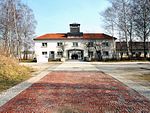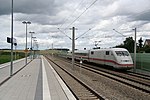Buchenwald trial
1947 in Germany1947 in lawAll pages needing cleanupBuchenwald concentration campDachau trials ... and 1 more
Wikipedia pages needing cleanup from September 2020

The Buchenwald trial or United States of America vs. Josias Prince of Waldeck et al. (also referred as Case 000-50-9) was a war crime trial conducted by the United States Army as a court-martial in Dachau, then part of the American occupation zone. It took place from April 11 to August 14, 1947 in the internment camp of Dachau, where the former Dachau concentration camp had been located until late April 1945. In this trial, 31 people were indicted for war crimes related to the Buchenwald concentration camp and its satellite camps, all of whom were convicted. The Buchenwald trial was part of the Dachau trials, which were held between 1945 and 1948.
Excerpt from the Wikipedia article Buchenwald trial (License: CC BY-SA 3.0, Authors, Images).Buchenwald trial
Camp Road,
Geographical coordinates (GPS) Address Website Nearby Places Show on map
Geographical coordinates (GPS)
| Latitude | Longitude |
|---|---|
| N 48.2703 ° | E 11.4681 ° |
Address
KZ-Gedenkstätte Dachau
Camp Road
85221
Bavaria, Germany
Open on Google Maps











